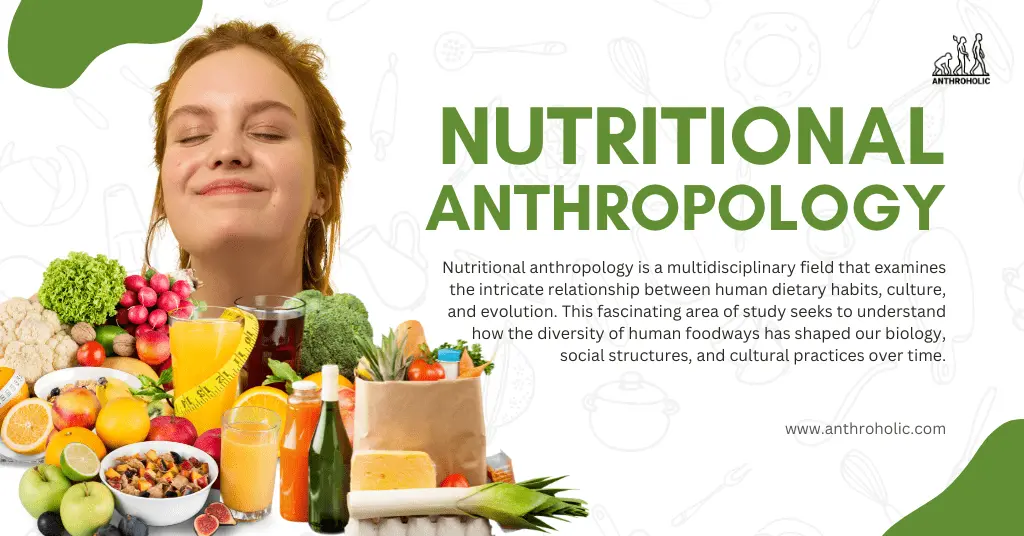AI Answer Evaluation Platform Live Now. Try Free Answer Evaluation Now
Nutritional Anthropology
Nutritional anthropology is a multidisciplinary field that examines the intricate relationship between human dietary habits, culture, and evolution. This fascinating area of study seeks to understand how the diversity of human foodways has shaped our biology, social structures, and cultural practices over time.

History of Nutritional Anthropology
Nutritional anthropology traces its roots back to the early 20th century, when anthropologists and biologists began to recognize the importance of studying diet in understanding human evolution and cultural variation (Grivetti & Ogle, 2000). Early works in this field focused on documenting and comparing the dietary habits of different cultures, both past and present. The field gained momentum in the 1960s and 1970s as researchers started to integrate concepts from nutrition science, ecology, and anthropology to develop a more holistic understanding of human diet (Mintz & Du Bois, 2002). This interdisciplinary approach allowed for the examination of dietary patterns in relation to environmental, social, and cultural factors, as well as the investigation of the biological consequences of these patterns.
Key Areas of Research
A. Evolution of the Human Diet
One of the primary focuses of nutritional anthropology is the study of the evolution of the human diet. Researchers in this area examine the dietary habits of our ancestors, aiming to understand how these habits have shaped our biology and influenced our cultural practices.
- Hominin Dietary Shifts
Table 1. Major Hominin Dietary Shifts and Their Implications
| Time Period | Dietary Shift | Implications |
|---|---|---|
| 7 million years ago | Emergence of bipedalism | Enabled access to new food sources, such as ground plants and meat from scavenging |
| 2 million years ago | Development of stone tools | Facilitated meat consumption and allowed for more efficient extraction of nutrients from plant foods |
| 1.8 million years ago | Expansion of Homo erectus out of Africa | Necessitated adaptation to new environments and dietary changes |
| 500,000 years ago | Control of fire | Made cooking possible, increasing the digestibility and nutritional value of food |
- The Agricultural Revolution
The development of agriculture around 10,000 years ago marked a major shift in human dietary habits, as people began to rely more heavily on cereal crops and domesticated animals for sustenance (Cohen, 2009). This change had significant implications for human health and social organization, leading to the rise of complex societies and the emergence of new dietary-related diseases.
B. Cultural Variation in Diet
Another key area of research in nutritional anthropology is the examination of cultural variation in diet, which involves the documentation and comparison of dietary patterns across different societies. This research can reveal how social, economic, and environmental factors influence food choices, and how these choices, in turn, shape cultural practices and beliefs.
- Food Taboos and Preferences
Table 2. Examples of Food Taboos and Preferences in Different Cultures
| Culture | Food Taboo | Food Preference |
|---|---|---|
| Hindu | Beef | Vegetarian dishes, such as lentils and rice |
| Jewish | Pork | Kosher foods, such as gefilte fish and matzo |
| Muslim | Pork | Halal foods, such as dates and lamb |
| Inuit | Raw fish and certain birds | Seal and whale meat, rich in fat |
- Dietary Adaptations to the Environment
Nutritional anthropologists also investigate how different cultures have adapted their diets to their specific environments. For example, the traditional Inuit diet, which consists mainly of marine mammals and fish, provides essential nutrients and energy needed for survival in the Arctic (Kuhnlein & Soueida, 1992). Similarly, the high-altitude populations of the Andes rely on potatoes and other tubers that are well-suited for cultivation in their mountainous environment (Johns, 1990).
Methods of Study
- Ethnographic Research: Ethnographic research, which involves the systematic observation and documentation of a culture, is a primary method used in nutritional anthropology. Through participant observation, interviews, and surveys, researchers can collect detailed information about the dietary habits, food preferences, and beliefs of a particular society (Pelto & Pelto, 1983).
- Archaeological and Paleontological Evidence: Archaeological and paleontological evidence, such as fossilized plant and animal remains, can provide important insights into the diets of past human populations. By analyzing these remains, researchers can reconstruct the types of foods consumed, as well as the methods used to process and prepare them (Ungar & Sponheimer, 2011).
- Stable Isotope Analysis: Stable isotope analysis is a powerful tool used in nutritional anthropology to determine the composition of ancient diets. By examining the ratios of different isotopes in human tissues, such as bones and teeth, researchers can infer the types of foods consumed and the relative importance of various food sources in an individual’s diet (Ambrose & Norr, 1993).
Noteworthy Findings and Implications
- The Importance of Dietary Diversity: Research in nutritional anthropology has highlighted the importance of dietary diversity for human health and well-being. Diverse diets, which include a wide variety of plant and animal foods, are more likely to provide adequate amounts of essential nutrients and protect against chronic diseases (Johns & Eyzaguirre, 2006).
- The Role of Culture in Shaping Diet: Nutritional anthropology has demonstrated that culture plays a crucial role in shaping dietary habits. Cultural beliefs, values, and practices can influence food choices, leading to the development of unique foodways that have significant implications for human health and well-being (Mintz & Du Bois, 2002).
- The Impact of Globalization on Diet: The field has also shed light on the impact of globalization on human diet. As food systems become increasingly interconnected, traditional diets and foodways are being transformed, often with negative consequences for human health and the environment (Hawkes, 2006).
Conclusion
Nutritional anthropology offers a unique perspective on the complex relationship between diet, culture, and human evolution. By integrating insights from multiple disciplines, this field has deepened our understanding of how our dietary habits have shaped our biology, social structures, and cultural practices over time. As we continue to face the challenges of globalization, climate change, and rising rates of chronic disease, the insights gained from nutritional anthropology can help guide our efforts to promote sustainable and healthy food systems for all.
FAQs about Nutritional Anthropology
See Also
References
- Aiello, Leslie C., and Peter Wheeler. “The Expensive-Tissue Hypothesis: The Brain and the Digestive System in Human and Primate Evolution.” Current Anthropology, vol. 36, no. 2, 1995, pp. 199–221. JSTOR, http://www.jstor.org/stable/2744104. Accessed 23 June 2023.
- Ambrose, S. H., & Norr, L. (1993). Experimental evidence for the relationship of the carbon isotope ratios of whole diet and dietary protein to those of bone collagen and carbonate. In J. B. Lambert & G. Grupe (Eds.), Prehistoric human bone: Archaeology at the molecular level (pp. 1-37). Springer.
- Antón, S. C., Potts, R., & Aiello, L. C. (2014). Evolution of early Homo: An integrated biological perspective. Science, 345(6192), 1236828.
- Cohen, M. N. (2009). The food crisis in prehistory: Overpopulation and the origins of agriculture. Yale University Press.
- Farb, P., & Armelagos, G. (1980). Consuming passions: The anthropology of eating. Houghton Mifflin.
- Grivetti, L. E., & Ogle, B. M. (2000). Value of traditional foods in meeting macro-and micronutrient needs: The wild plant connection. Nutrition Research Reviews, 13(1), 31-46.
- Harris, M., & Ross, E. B. (1987). Food and evolution: Toward a theory of human food habits. Temple University Press.
- Hawkes, C. (2006). Uneven dietary development: Linking the policies and processes of globalization with the nutrition transition, obesity and diet-related chronic diseases. Globalization and Health, 2(1), 4.
- Johns, T. (1990). With bitter herbs they shall eat it: Chemical ecology and the origins of human diet and medicine. University of Arizona Press.
- Johns, T., & Eyzaguirre, P. B. (2006). Linking biodiversity, diet and health in policy and practice. Proceedings of the Nutrition Society, 65(2), 182-189.
- Kiple, K. F., & Ornelas, K. C. (2000). The Cambridge world history of food (Vol. 1). Cambridge University Press.
- Kuhnlein, H. V., & Soueida, R. (1992). Use and nutrient composition of traditional Baffin Inuit foods. Journal of Food Composition and Analysis, 5(2), 112-126.
- Mintz, S. W., & Du Bois, C. M. (2002). The anthropology of food and eating. Annual Review of Anthropology, 31(1), 99-119.
- Pelto, G. H., & Pelto, P. J. (1983). Diet and delocalization: Dietary changes since 1750. Journal of Interdisciplinary History, 14(2), 507-528.
- Ungar, P. S., & Sponheimer, M. (2011). The diets of early hominins. Science, 334(6053), 190-193.
- Wrangham, R. (2009). Catching fire: How cooking made us human. Basic Books.



